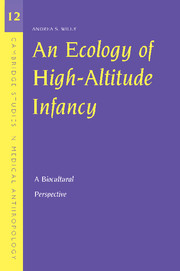Book contents
- Frontmatter
- Contents
- List of Figures, Photographs, and Tables
- Acknowledgments
- Abbreviations
- Glossary of Ladakhi Words
- An Ecology of High-Altitude Infancy
- 1 Introduction
- 2 Challenges of High-Altitude Living
- 3 Contextualizing Reproductive Health Research in Ladakh
- 4 Big Mountains, Small Babies
- 5 An Ecology of Infancy in Ladakh
- 6 Comparative Perspectives on Reproductive Health in Ladakh
- 7 Toward Relevant Research: Adaptation and Policy Perspectives on Maternal-Infant Health in Ladakh
- Notes
- References
- Index
- Titles in the series
2 - Challenges of High-Altitude Living
Published online by Cambridge University Press: 18 December 2009
- Frontmatter
- Contents
- List of Figures, Photographs, and Tables
- Acknowledgments
- Abbreviations
- Glossary of Ladakhi Words
- An Ecology of High-Altitude Infancy
- 1 Introduction
- 2 Challenges of High-Altitude Living
- 3 Contextualizing Reproductive Health Research in Ladakh
- 4 Big Mountains, Small Babies
- 5 An Ecology of Infancy in Ladakh
- 6 Comparative Perspectives on Reproductive Health in Ladakh
- 7 Toward Relevant Research: Adaptation and Policy Perspectives on Maternal-Infant Health in Ladakh
- Notes
- References
- Index
- Titles in the series
Summary
Human populations living at high altitude must find ways to adapt to a unique complex of ecological stresses. Hypoxia is the best studied of these, but it often occurs in conjunction with high levels of short-wave (UV) radiation, dramatic seasonal or diurnal variation in temperature resulting in periods of intense cold, and harsh and barren terrain. Mountainous regions of the world vary greatly in their geographies, but they are linked by this package of ecological features. These have both direct and indirect effects on human biology insofar as they constrain the possibilities for food production and influence the distribution of disease-causing microorganisms, among others. Further, these ecological factors act as stressors – singly, additively, or interactively – on individuals and populations, and ultimately they can have effects on people's health and well-being. The elevation of 2500 meters is often used as the cutoff to distinguish “high” from “low” altitude, but this is only a rough indication of when most people begin to experience the physiological effects of hypoxia and where other aspects of high-altitude ecology become increasingly apparent (Pawson and Jest 1978).
It is estimated that over 140 million people live in the mountainous areas of the world, the majority in the Andes and Himalaya. There are also substantial populations in the East African highlands, the European Alps, and the Rockies of the United States (Moore et al. 1998). These areas have been inhabited by humans for widely varying lengths of time.
- Type
- Chapter
- Information
- An Ecology of High-Altitude InfancyA Biocultural Perspective, pp. 25 - 38Publisher: Cambridge University PressPrint publication year: 2004



